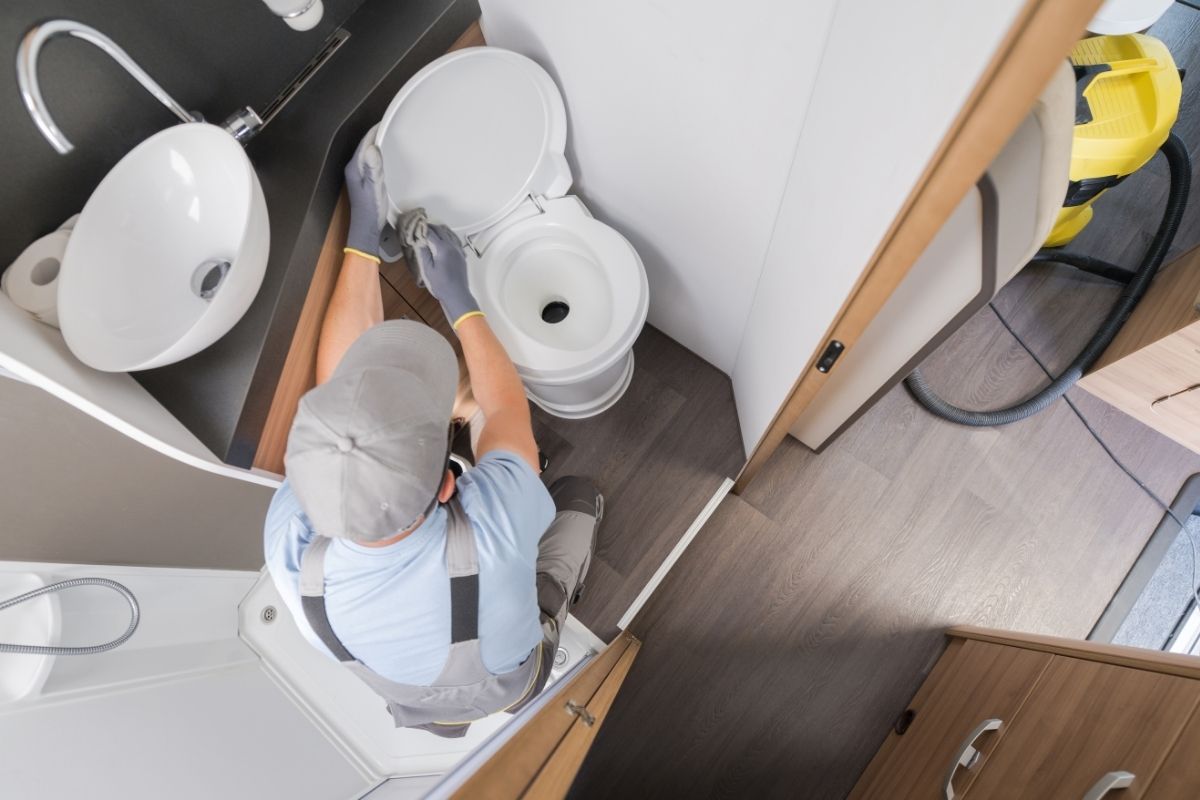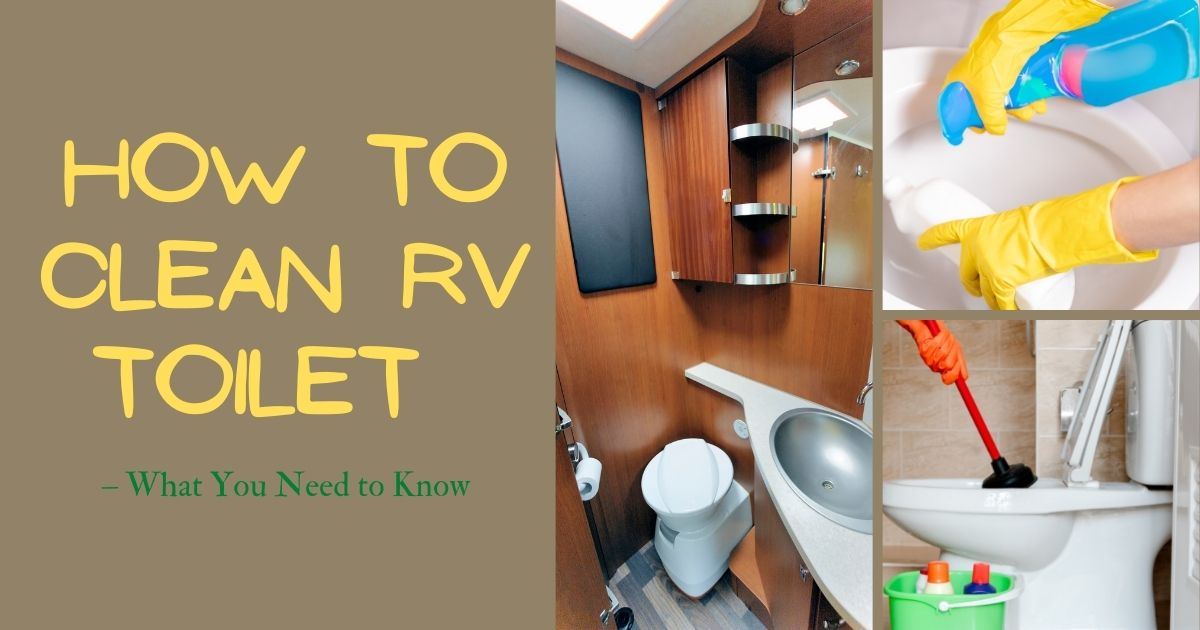Cleaning an RV Toilet
How to clean RV toilet follows the same physical steps as cleaning your house toilet. The type of solution you use and the cleaning instrument make a significant difference when cleaning your RV toilet versus your home toilet.
Chemical-based toilet cleaners are commonly used to clean toilet bowls in homes, but they are not the greatest choice for RVs. Let’s look at the top RV toilet cleaner and work tools.

Types of RV Toilets
Even though you can clean most RV toilets the same way, there are several types of toilets. The most typical RV toilet has a link to your water supply, flushes with a foot peddle, and empties into your black tank. Those toilets can be porcelain, which is more expensive, or less expensive plastic.
Cassette toilets are common in smaller RVs like pop-up campers and truck trailers. These feature a built-in freshwater reservoir and connect to a small waste cassette. The cassette flushes down the toilet. You do not require a plumbing system.
A composting toilet is another RV alternative toilet. It does not require a plumbing system or water to function. You dump the trash into a lower holding tank, where the liquids evaporate and the sediments become fertilizer.
How to Clean RV Toilet – Our Top Tips
Do you know how to clean RV toilet pipes, tanks, and bowls? The following tips will be helpful;
- Fill the bowl halfway: This will assist in minimizing streaking.
- Use a brush or sponge that isn’t abrasive: Cleaning RV toilet every other day is advisable.
- Use the attached sprayer: Many RV toilets have an attached sprayer when the flush isn’t strong enough. Keep a little plastic cup accessible and pour it around the toilet bowl as you flush if you don’t have one. A little spray bottle or a plastic water cannon may also suffice.
- Apply fiberglass RV wax to the inside of the toilet: This will smooth out the surface and make it more stain-resistant. Do this approximately once a month.
- Turn off the bathroom vent when flushing: To keep your RV from stinking, your first task is to switch on the bathroom fan. There’s nothing wrong with this action because it can eliminate odors. But, keep in mind that if you flush with the fan on, you will suck out the nasty fumes out of your holding tank and into your bathroom. So, run the fan except when flushing.
- Keep your black tank clean: When you flush the toilet, this will help to eliminate odors. How often should you empty your tank? Your gauges should indicate how full the tank is. However, covering the sensors can make it unreliable.
Depending on how many people are in it, you should probably dump your rig at least once a week. Flushing your tank after each dump can keep your tank and sensors cleaner.
- Use toilet paper that dissolves: This does not have to be the high-priced one from an RV retailer. Compare store brand dissolvability to more expensive RV-specific products in YouTube videos.
- Every time you empty your black tank, use drop-in packets, liquid, or dissolvable treatment: Enzymes in these substances aid in the breakdown of waste and tissue. Camco’s ultra-concentrated RV toilet treatment drop-ins are recommended.
- The most effective cleaning solutions: To avoid harming your RV’s equipment, use a specific camper toilet cleaner. Avoid using concentrated cleaners, scouring powders, and other harsh chemicals on a toilet since they can harm the toilet, break the toilet seal, and potentially void any guarantee you may have on the toilet.
Some vinegar and baking soda combination is the first line of defense. Add a third cup of vinegar to the bowl, followed by a pinch of baking soda. It will bubble before cleaning your toilet. You can also spray the toilet with the vinegar solution in a plastic container. Scrub the toilet brush with baking soda.
What do you Need to Clean an RV Toilet?
It’s critical to clean your RV toilet using the proper cleaning supplies. Not only do RV toilets come in a variety of materials, but any cleaner you use in your toilet will deposit in the black tank of water.
Ensure that you’re using safe, non-abrasive toilet bowl cleaners that work on various surfaces and are effective.
All toilet cleaners fall into one of two categories, both of which are important to RVers:
Chemical-based and chemical-free. Knowing the difference between these two sorts of toilet-cleaning chemicals is critical because picking the wrong one might harm your entire wastewater system’s efficiency.
Toilet Bowl Cleaners Using Chemicals
Chemical cleaners include chlorine or bleach-based toilet bowl cleaners, the kind you might already have beneath your kitchen sink. While the chemical components of these cleaners are effective in removing debris from your RV toilet, what do you do once you’re through? You flush all of the chemical cleaners into the black tank.
If you’re utilizing bacteria-based tank treatments, flushing this cleanser into the black tank will kill all of the bacteria in the tank, preventing waste decomposition. So, by employing these cleaners, you’re also wasting money because the bacteria-based treatment you introduced to the tank is suddenly ineffective.
By eliminating chemical-based toilet cleaning products, you can avoid flushing money down the toilet and potential complications.
Toilet Bowl Cleaners without Chemicals
Unique RV Toilet Cleaner plus a holding tank enhancer is the greatest toilet bowl cleaning product for an RV. It is chemical-free, won’t damage the toilet bowl, and boosts bacteria colonies in the black tank.
Unique RV toilet bowl cleaner is unique because it gives the microorganisms in your black tank a boost in breakdown energy. Cleaning your toilet bowl strengthens the breakdown process inside your RV’s black water holding tank.
Just because Unique RV Toilet Cleaner adds a bacteria and enzyme blend to your tank doesn’t mean regular toilet bowl cleanings with this product will eliminate the need for tank treatments. To keep your holding tank odor and clog-free, you should regularly use a high-quality tank treatment like Unique RV Digest-It.
Sponge or non-abrasive bowl brush
Apart from the cleaning solution, ensure you have a non-abrasive brush or sponge to use for cleaning the RV toilet. The sponge will prevent scratches on the toilet bowl.
Cleaning your camper toilet is simple if you have the right cleaning supplies. The following are steps on how to clean RV toilet;

Spray the Toilet Bowl With Cleaner First.
This is how to clean RV toilet bowl; Apply cleanser evenly to the inside of your toilet bowl. Allow for 5 to 10 minutes for the bowl cleaner to break down any stains or build-up.
Scrub the Bowl
After that, scrub the toilet bowl clean with your non-abrasive bowl brush or sponge. Using a soft-bristle brush or non-abrasive sponge if you have a plastic toilet is even more crucial because they scratch easily.
Use Clean Water to Rinse
Flush the toilet severally after scrubbing to clean it out. The cleanser will flush down to your black holding tank, which will assist in the breakdown of waste.
Important: Do not use intense cleaners, scouring powders, or other harsh chemicals on your toilet since they may harm it, damage the seal, and void whatever warranty you may have on it.
Keeping Your RV Toilet Smelling Fresh
Because a camper toilet differs from a home toilet, there are a few guidelines you can follow to ensure that the toilet and the RV bathroom, and the entire vehicle remain clean and fresh.
Regular Cleaning of Your Toilet
You should clean your RV toilet regularly to maintain it as clean as possible and make subsequent cleanings easier. Flushing frequently is also an excellent idea.
Regularly Cleaning Your Black Tank
Your black water tank, not your toilet, is the main culprit if your RV bathroom is starting to smell less than fresh. Because your toilet sits atop a massive tank holding your waste, a foul odor coming from the tank isn’t surprising. However, by regularly cleaning your black water tank, you can keep the stink from escaping.
Make use of Drop-In Packets.
Of course, you won’t be able to keep it clean all of the time, but you may use drop-in packets to keep it smelling fresh in between cleanings. These specialized black tank treatments aid in the breakdown of waste and eliminating odors. They’re also easy to use: drop one in your toilet and flush it.
The Difference Between a Home and RV Toilet Bowl
The distinctions between a typical household toilet and an RV toilet are numerous. These distinctions may persuade you that conversion is not the best option:
- A standard toilet handles a lot of water; however, the RV requires a little amount of water.
- A typical toilet rests on a drain pipe and requires a lot of water to flush the waste. On the other hand, an RV toilet sits on top of the black water tank and only requires a small amount of water to empty.
- A wax seal prevents a conventional toilet from leaking while an RV toilet uses a rubber seal to do the same.
- A conventional toilet is intended for residential use; however, an RV toilet is not.
- An RV toilet is smaller than a standard toilet. An RV toilet functions in a tiny place to save space.

Final Thoughts
Toilets in RVs are not the same as toilets in homes. Apart from apparent distinctions such as plumbing and water usage, RV toilets are frequently fashioned of various materials. (Check out the RV toilet system diagram above to see the difference)
Furthermore, because your RV toilet does not flush into a septic system or municipal sewage system like a residential toilet, anything you use to clean your toilet bowl will impact your holding tank.
Always choose suitable cleaning materials, check out ways to use the right cleaning tools to avoid damage, and some best practices to keep your RV toilet in good working order.
